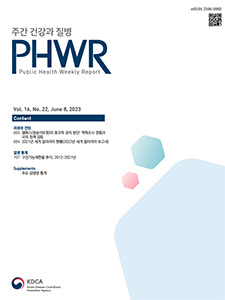Current Issue
Vol.16 No.22, June 08, 2023
-
Review & Perspective 2023-06-08
 1
1
 1905
1905
 445
445
Effective Responses to Mpox (Monkeypox): Epidemiologic Investigation and Foreign Policy
Taeyoung Kim, Eonjoo Park, Jongmu Kim, Min Gyeol Shim, Shinyoung Lee, Eunkyoung Kim
Public Health Weekly Report 2023; 16(22): 669-683 https://doi.org/10.56786/PHWR.2023.16.22.1AbstractThe ongoing global epidemic of mpox shows characteristics of sexually transmitted infections (STIs), with men who have sex with men being particularly vulnerable to infection. While the Republic of Korea has only reported around fifty confirmed mpox cases, preparing for a potential epidemic is imperative. To investigate private areas such as sexual contact, appropriate interview skills should be utilized while protecting the rights of vulnerable populations. Previous epidemiologic investigations and global principles employed while investigating HIV and STIs suggest involving vulnerable populations in the investigation. It is essential to establish investigation principles and mpox policies that consider the unique features of vulnerable populations to prevent stigma and discrimination against them. Moreover, such policies promote their engagement in the fight against the disease.
-
Review & Perspective 2023-06-08
 0
0
 3812
3812
 755
755
Status of World Malaria in 2021 (2022 World Malaria Report)
Hyun-Il Shin, Bora Ku, Esther Park, Jung-Won Ju, Hee-Il Lee
Public Health Weekly Report 2023; 16(22): 684-706 https://doi.org/10.56786/PHWR.2023.16.22.2 Abstract
AbstractMalaria is an acute febrile disease transmitted through the bite of Anopheles spp. infected with Plasmodium spp. protozoa. This disease occurs mostly in tropical regions. Five species of malaria can infect humans, Plasmodium falciparum, P. malariae, P. ovale, P. vivax, and P. knowlesi, of which P. falciparum and P. vivax are known to be the most important parasites for human. P. falciparum is most prevalent in Africa, while P. vivax is most prevalent in Southeast and Western Pacific Asia. P. malariae and P. ovale occur in parts of Africa, while P. knowlesi occurs only in parts of Malaysia and Indonesia. P. falciparum accounts for the most malaria deaths, whereas P. vivax presents a lower mortality risk rate than P. falciparum. According to the 2022 World Malaria Report by World Health Organization (WHO), it was the number of infected cases and malaria-related deaths in 2021 were estimated to be 247 million and 619,000, respectively. Regionally, the most cases in 2021 occurred in the African Region (95%) including Nigeria (26.6%), the Democratic Republic of the Congo (12.3%), Uganda (5.1%), Mozambique (4.1%), Angola (3.4%), and Burkina Faso (3.3%). Furthermore, children under the age of 5 accounted for 76% of all malaria deaths. Belize and Cabo Verde reported zero malaria cases for the third consecutive year, and many other countries are also moving towards malaria elimination. Paraguay, Argentina, and El Salvador were certified malaria free in 2018, 2019, and 2021, respectively. The Division of Vectors and Parasitic Diseases, the Korea Disease Control and Prevention Agency (KDCA) has been striving to maintain a high level of diagnostic and surveillance capacities, while collaborating with international and national agencies to control and eliminate malaria.
-
QuickStats 2023-06-08
 0
0
 3942
3942
 526
526
Trend in the Rate of Limited Oral Function, 2012-2021
Public Health Weekly Report 2023; 16(22): 707-708 https://doi.org/10.56786/PHWR.2023.16.22.3

pp. 1433~1461
Most Keyword
?
What is Most Keyword?
- It is the most frequently used keyword in articles in this journal for the past two years.
Most Read
-
Waterborne and Foodborne Disease Outbreaks in the Republic of Korea, 2023
Myung-Jae Hwang, So Yeon Park, Hyungjun Kim, Se Jeong Yang, Sungchan Yang, Jin Seon Yang
Public Health Weekly Report 2025;18: 17-32 https://doi.org/10.56786/PHWR.2025.18.1.2 -
Implementation Plan for the Coronavirus Disease 2019 Vaccination for the 2024–2025 Season: Recommendations of the 6th Expert Committee on Immunization Practices
Hyewook Hwang, Wookeon Lee, Seohyeon Ahn, Young-Sook Choi, Seunghyun Lewis Kwon, Dongwoo Lee, Eun Hwa Choi, SokGoo Lee
Public Health Weekly Report 2025;18: 90-102 https://doi.org/10.56786/PHWR.2025.18.2.3
Editorial Office
+82-43-719-7569





 Full Text
Full Text Cite
Cite


